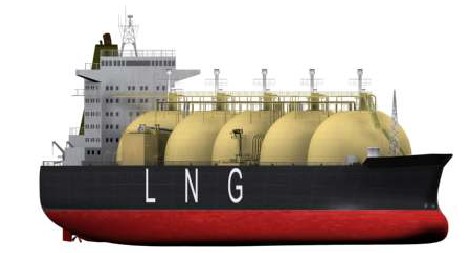

Home page|||
LNG handling |||
LPG handling||| Other Gas products|||
Fire & Safety|||
Emergency response |||
The double hull feature & general arrangement for liquefied gas carriers
All Liquefied Gas Carriers have two hulls, in effect
a "double ship" that protects the
cargo in a collision or grounding.Gas carriers have a similar overall arrangement to tankers in that their
machinery and accommodation are aft and the cargo containment is spread
over the rest of the ship to forward where the forecastle is fitted.
Specific gravity of LPG cargoes can vary from 0.58 to 0.97 whilst LNG
ships are often designed for a cargo specific gravity of 0.5 so that a characteristic
of LNG ships in particular and most LPG ships is their low draft
and high freeboards. Water ballast cannot be carried in the cargo tanks so
adequate provision is made for it within the double hull spaces, double
bottom, bilge tank, and upper wing tank spaces.

Fig:LNG carrier moss tanks
Due to the extra care in designing, maintaining, operating, and inspecting LNG ships, they
have an excellent safety record.
The double hull feature of LNG carriers and many LPG ships is a
required safety feature and the tanks of LPG ships which do not have this
feature are required to be a minimum distance inboard of the shell.
Fore end and aft end structure is similar to that for other ships. The
cargo section is transversely or longitudinally framed depending primarily
on size in the same manner as other cargo ships, the inner hull receiving
special consideration where it is required to support the containment system.
All gas ships have spaces around the tanks which are monitored for gas
leaks and in many ships these spaces are also inerted, an inert gas system
being fitted aboard the ship. Liquid gas cargoes are carried under positive
pressure at all times so that no air can enter the tanks and create a flammable
mixture.
Liquefaction equipment is provided aboard LPG ships, ‘boil off’ vapour
from the tanks due to any heat ingress is drawn into the liquefaction plant
and returned to the tank. Boil off vapour from LNG ship tanks can be utilized
as a boiler fuel in steam ships, otherwise it is vented to atmosphere, although
this is not permitted in many ports, and several other solutions have been
developed to overcome this problem.
Below is our guideline for various type gas carriers availble
Related Information:
-
Liquefied gas carrier safety training
- Benifits of compressed gas technology
- Compressed gas liquid carriers (CGLC)
- Development and potential of todays emerging gas technologies
- Transporting economically viable compressed gas liquids from remote fields
- Increased Cargo Capacity for LNG ships & Advantages of the dual fuel diesel electric propulsion
Type of gas carriers - variation in the design, construction and operation
Transporting liquefied natural gases by LNG ships
External links :
-
IMO publications

// Home page///
LNG handling ///
LPG handling///
Sea transport ///
Gas products///
Cargo work
///Fire precautions
///Health hazards
///Safety Precautions
///Emergency response ///

Copyright © Liquefied Gas Carrie.com All rights reserved.
The content published in this website are for general reference only. We have endeavoured to make the information
as accurate as possible but cannot take responsibility for any errors. For latest information please visit www.imo.org .
Any suggestions, please Contact us !
///Links &Resources //
Terms of use///
Privacy policy///Home page///

